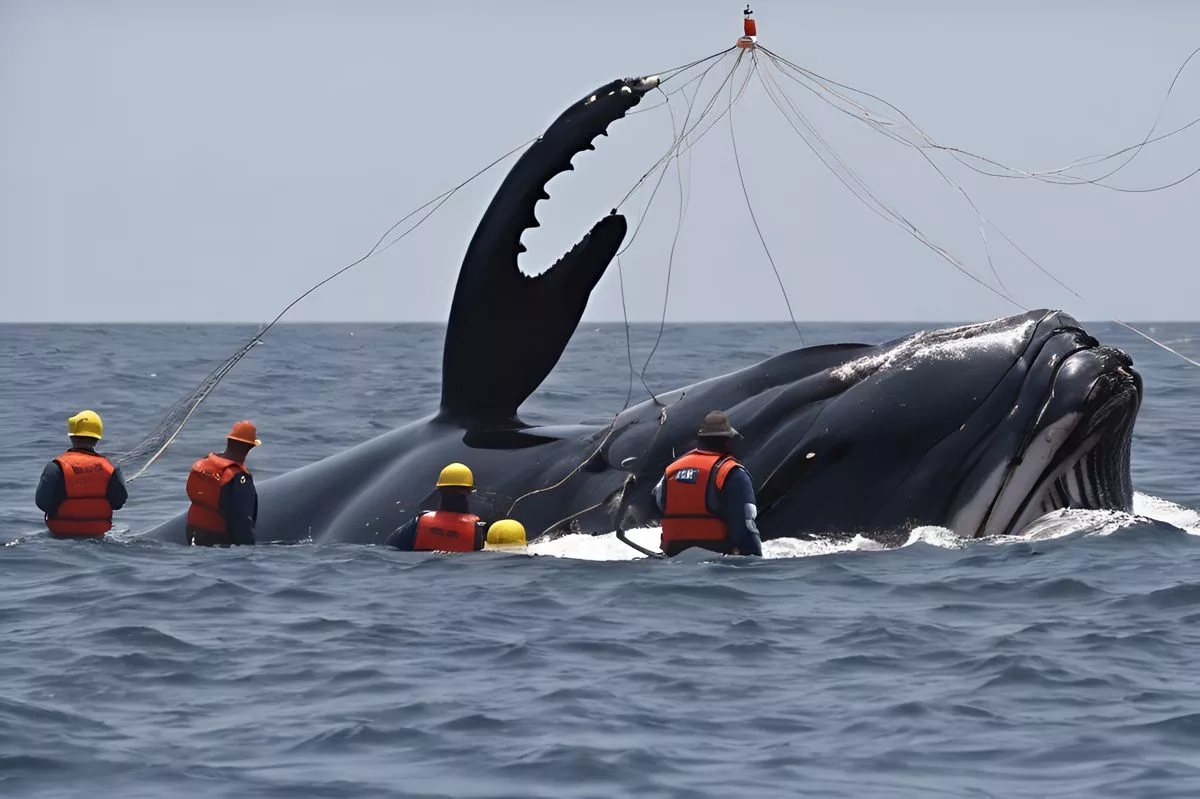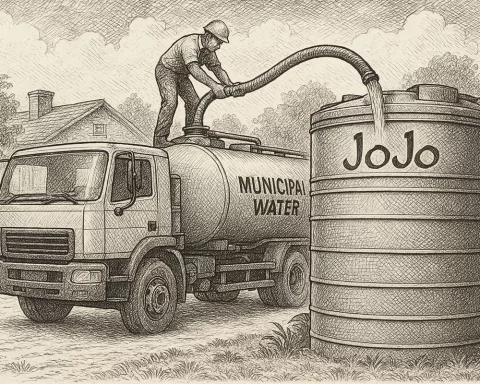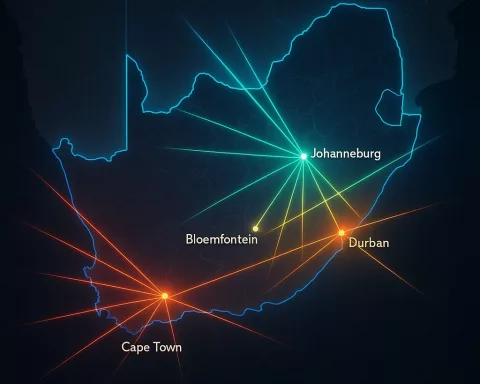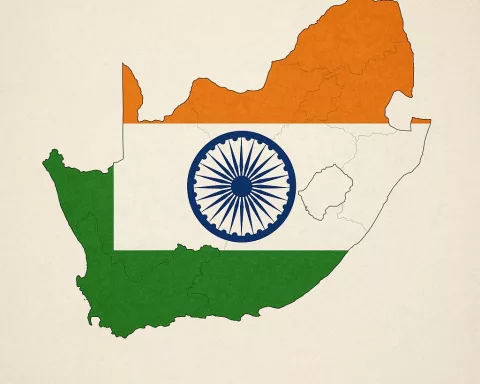In Hermanus, South Africa, a young Southern Right whale was rescued from a fishing line by the South African Whale Disentanglement Network (SAWDN) with the help of the National Sea Rescue Institute (NSRI) on June 28th. Despite the challenges faced during the intricate rescue operation, the whale was successfully freed from most of the line and was monitored by the SAWDN for a few days. The incident highlights the importance of managing marine debris and the urgency of international collaboration for ocean conservation.
How was a whale rescued in Hermanus?
A young Southern Right whale was ensnared in a fishing line in Hermanus, South Africa, and was rescued by the South African Whale Disentanglement Network (SAWDN) on June 28th. The rescue operation was carried out by the National Sea Rescue Institute (NSRI) with the help of the SAWDN NSRI crew. The whale was successfully freed from most of the line and was monitored by the SAWDN for a few days. This incident highlights the importance of managing marine debris and the urgency of international collaboration for ocean conservation.
Under the glittering sun of Hermanus’s offshore waters, a compelling maritime tale unfolded on a recent Friday. A blend of human compassion and technical competence was put to test in a daring attempt to liberate a whale ensnared in a fishing line. This distressing incident was reported to the South African Whale Disentanglement Network (SAWDN) on June 28th. This case underlines the network’s unwavering commitment to ensuring the wellbeing of these majestic aquatic beings.
Act One: The Discovery and the Rescue Mission
The Miroscha, a local whale-watching charter vessel, set the stage for this remarkable rescue act. It provided crucial support by maintaining a safe distance while keeping an eye on the whale. The National Sea Rescue Institute (NSRI) identified that the whale was ensnared in a fishing line around its tail. In response to this challenging task, at 9:37 am, the NSRI Hermanus sent out their rescue boat, aptly named Rescue 17 Alpha Leonard Smith. Accompanying the boat was a skilled SAWDN NSRI crew, equipped with specialized cutting tools and prepared to carry out a meticulous yet hazardous operation.
Upon arriving at the scene, the rescuers discovered a young Southern Right whale, approximately eight to nine meters in length. A disheartening sight beheld them. The whale’s tail, flukes, and peduncle were entangled in copious amounts of tuna monofilament long line. More disturbingly, the line had cut into the whale’s skin, indicating the entanglement wasn’t recent.
The mystery of how the fishing line ended up there is yet to be solved. Such incidents highlight the importance of managing marine debris and the urgency of international collaboration for ocean conservation. Equipped with SAWDN cutting tools, the rescue team cautiously approached the whale with one mission in mind—to liberate the whale from its painful bonds.
Act Two: The Intricate Battle
The rescue operation wasn’t without its hitches. The meticulous procedure of severing the line inflicted considerable damage to SAWDN’s specialized equipment. Nonetheless, persistence paid off as a substantial part of the line was detached, allowing the whale more freedom of movement. The whale then plunged underwater, momentarily disappearing from sight.
As the day wore on, a ray of hope began to shine. Local whale charter vessel Umnati confirmed the reappearance of the whale. After observing the whale, the NSRI rescue boat noted that despite a portion of the fishing line remaining tangled around its tail and flukes, the whale was swimming freely. Unfazed by the earlier challenges, the NSRI crew continued their mission. The team succeeded in removing roughly 90% of the remaining line, except for a small section which had significantly loosened.
Act Three: The Continued Vigilance
Dedicated to their rescue mission, the team kept watch over the weekend. On Sunday, they spotted the whale off Sandbaai’s shore, seemingly swimming freely despite some line still tangled around its tail. The saga resumed on Tuesday, July 2nd, as coast watchers identified the same whale off Walker Bay’s shore, heading towards Gansbaai. In an attempt to remove the last trace of the line, the Rescue 17 Alpha Leonard Smith was once again dispatched. However, due to heavy sea swells, any rescue attempts were thwarted.
Despite these challenging conditions, a glimmer of hope still prevails. As confirmed by Mike Meyer of SAWDN, the whale seems to be swimming freely, and the remaining line appears to be loose. As the SAWDN continuously monitors the situation, waiting for an opportunity to remove the last bit of line, the surveillance continues.
This heroic tale symbolizes the dynamic relationship between mankind and nature, emphasizing our obligation to protect and conserve our earth. It also serves as a stern reminder of the urgent need for worldwide collaboration in marine conservation and sustainable fishing practices. As we marvel at these magnificent creatures, let’s not forget our duty to ensure their freedom and safety in the vast ocean expanses.
1. What happened in Hermanus, South Africa on June 28th?
A young Southern Right whale was ensnared in a fishing line and was rescued by the South African Whale Disentanglement Network (SAWDN) with the help of the National Sea Rescue Institute (NSRI).
2. Who carried out the rescue operation?
The rescue operation was carried out by the National Sea Rescue Institute (NSRI) with the help of the SAWDN NSRI crew.
3. Was the whale successfully rescued?
The whale was successfully freed from most of the line and was monitored by the SAWDN for a few days. Some line still remains tangled around its tail, but the whale appears to be swimming freely and the SAWDN is monitoring the situation.
4. Why is this incident important?
This incident highlights the importance of managing marine debris and the urgency of international collaboration for ocean conservation.
5. What challenges did the rescuers face during the operation?
The rescue operation was meticulous yet hazardous, and the procedure of severing the line inflicted considerable damage to SAWDN’s specialized equipment.
6. What does this incident symbolize?
This heroic tale symbolizes the dynamic relationship between mankind and nature, emphasizing our obligation to protect and conserve our earth, and serves as a stern reminder of the urgent need for worldwide collaboration in marine conservation and sustainable fishing practices.












